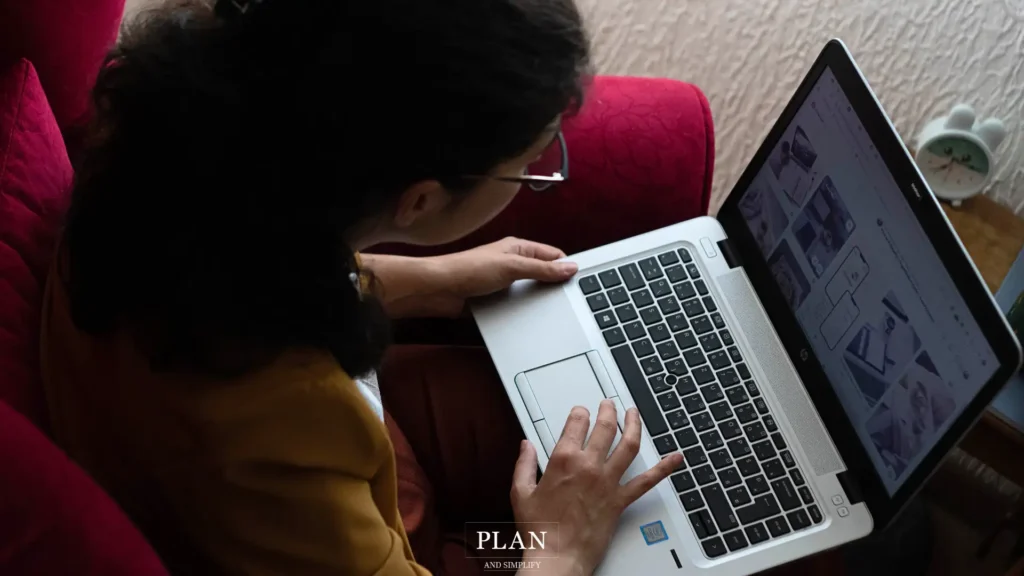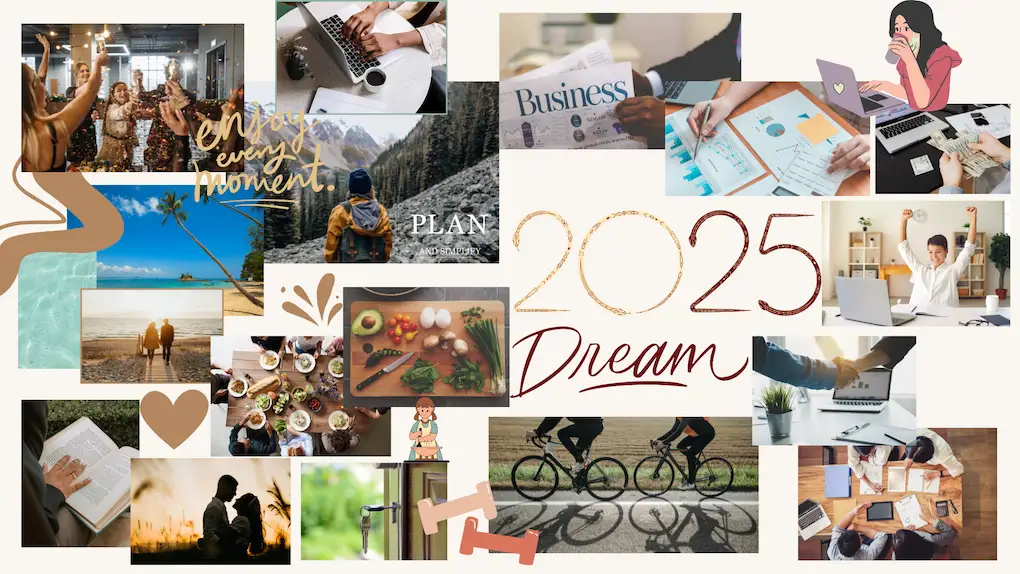I know that learning how to create a vision board might sound intimidating, but I think it’s one of the simplest ways to get clear on what you want from life. Whether you’re looking for a mid-year reset or planning ahead for 2025, the process involves just five straightforward steps: defining your goals, gathering images, choosing your format, arranging everything meaningfully, and placing it where you’ll see it daily.
You can go the traditional route with magazines and poster board, or create a digital vision board like I do – I’ll walk you through the digital approach since that’s honestly what works best for my schedule.
Why You Need a Vision Board
Most of us are living on autopilot, going through the motions without a clear picture of where we’re heading. We know we want “more” or “better” but can’t articulate what that actually looks like. Without a visual representation of our goals, we get caught up in daily tasks and lose sight of the bigger picture we’re working toward.
I started making vision boards three years ago when I felt completely stuck in my routine. I was going through the motions, feeling like I was just surviving each week rather than building toward anything meaningful. The problem wasn’t that I didn’t have goals – it’s that they lived only in my head, competing with a thousand other thoughts and daily distractions.
When your goals aren’t visible, they’re forgettable. You might want to travel more, advance your career, or create a healthier lifestyle, but without a constant visual reminder, these dreams get buried under immediate responsibilities. That’s where vision boards come in – they make your future tangible and keep your aspirations front and center when motivation starts to fade.
What Is a Vision Board and What Should It Include
So, what is a vision board? It’s essentially a visual representation of your goals and dreams – think of it as your future self staring back at you from a collection of images, words, and quotes. The goal isn’t some mystical manifestation magic (though I won’t argue if that happens), but to see your goals clearly so they can motivate you when you’re feeling overwhelmed.
Research backs this up too; psychologists have found that visualizing your goals through vision boarding can significantly improve your chances of achieving them by keeping your objectives at the forefront of your mind and helping your brain recognize opportunities that align with your aspirations.
What Should a Vision Board Include
Your vision board should include whatever speaks to your soul and represents the life you’re working toward. Things to put on a vision board typically include career milestones you want to hit, places you want to travel, the kind of home environment you’re creating, relationships you want to nurture, and even small daily experiences that bring you joy, like that perfect morning coffee setup or the feeling of finishing a good workout.
It’s basically anything you can think of – don’t feel like you should follow what everyone else puts on their board.
Vision Board Ideas to spark your creativity:
Here are some specific ideas to spark your creativity:
- Career aspirations: Pics of your dream office, women in leadership roles, speaking at conferences, team collaborations, or your ideal work-life balance
- Travel destinations: Photos of specific places you want to visit, cultural experiences you crave, or that perfect beach vacation you’ve been planning
- Health and wellness: Pictures of activities you want to try, healthy meals that excite you, fitness goals, or peaceful moments of self-care
- Relationships and family: Images representing quality time with loved ones, date night ideas, family traditions you want to create, or friendships you want to nurture
- Home and lifestyle: Your dream living space, cozy reading nooks, organized spaces, or that perfect morning routine setup
- Personal growth: Books you want to read, skills you want to learn, creative projects calling to you, or mindfulness practices you want to adopt
- Financial goals: Visual representations of financial freedom, that emergency fund milestone, investment goals, or experiences you’re saving for
How to Create a Vision Board: 5 Simple Steps
Creating a vision board from scratch can feel overwhelming when you’re just starting out, but there are tools (like Canva!) that can help simplify the process. I used this process for my 2025 vision board, and for all my other boards. You can make them for the entire year, or for specific monthly goals.
Step 1: Get Clear on Your Vision Categories
Before you start collecting pretty pictures, spend 15 minutes writing down what you want in different areas of your life. I break mine into five categories: career and money, relationships and family, health and wellness, experiences, and personal growth.
Don’t overthink this part or worry about being too specific. If you know you want more flexibility in your work life but aren’t sure exactly what that looks like, write “more work flexibility” and trust that the right images will speak to you later. I’ve found that being too rigid in this stage can limit the possibilities you’re open to discovering.

Step 2: Choose Your Digital Platform
I’m a huge fan of digital vision boards because they’re so much easier to update and access from anywhere. Canva vision board creation is my go-to approach – they have tons of vision board template options that make the whole process easy, plus you can easily search for images without hunting through magazines.
You can also use Pinterest to create a private board, or even just create a simple collage in your phone’s photo editing app. The beauty of going digital is that you can have multiple versions. I keep one on my phone as my lock screen, another as a desktop wallpaper, and a detailed Canva vision board that I update seasonally.
If you’re more of a hands-on person, there’s nothing wrong with the traditional poster board approach, but I’ve found digital boards fit better into busy lifestyles and get seen more often.
Step 3: Find Images That Move You
This is my favorite part! Start by searching for images related to your categories, but don’t force it – let yourself wander and save anything that makes you feel excited or inspired. As I mentioned, I like using Canva for creating my vision boards. I look for photos of career achievements I want, travel destinations that call to me, cozy home vibes I’m working toward, and even abstract images that represent feelings I want more of in my life.
The key is choosing images that bring up emotions, not just look pretty. That photo of someone confidently leading a meeting might represent the leadership role you’re working toward, while an image of a beautifully organized home office could capture your desire for better work-life boundaries. I usually end up with way more images than I need, which is perfect because you want options when you start arranging everything.
I love adding quotes and illustrations that tie up the whole section – I think it really brings it to life.
Step 4: Arrange Your Vision Board Layout
Now comes the fun part of creating your vision board collage. If you’re using a vision board template, you can simply drag and drop your chosen images into the designated spots, but I prefer starting with a blank canvas so I have complete creative control. I use a desktop layout for my laptop, and a phone layout for my lock screen.
Place your most important goals prominently – these should be the images your eye goes to first. I like to create flow and visual harmony by grouping related goals together and using a mix of large statement images and smaller supporting ones. Don’t worry about making it look like something from Pinterest; your vision board should feel authentically you.
I add text overlays with specific goals or affirmations, and sometimes include dates for things I’m working toward, which helps make everything feel more tangible and achievable.
Step 5: Make It Visible and Accessible
The final step in how to make a vision board effective is placing it where you’ll see it every day. I sometimes print a smaller version for my desk and create digital versions for different devices. Some people create digital photo frames that cycle through their vision board images, while others set their boards as laptop backgrounds (like I do).
The point is to integrate it into your daily routine so you’re reminded of your goals when you need motivation most. I look at mine every time I open my laptop or unlock my screen. When you’re having one of those days where everything feels pointless and overwhelming, having that visual reminder of your bigger picture can be the nudge you need to keep going.
Pro tip: Create a folder on your laptop and add all your relevant vision boards if you have multiple ones that are “active.” Then set your wallpaper to switch them on a 30-minute interval. That way you get to see all of them.

Vision Board Examples and Inspiration
I wanted to share some of my own vision boards to give you a sense of what these can look like in practice. My whole-year board typically includes big-picture goals like career milestones, major travel plans, and relationship intentions – it’s the 30,000-foot view of what I want my year to look like.
Seasonal boards get more specific and tactical, focusing on what I want to accomplish in the next three months, including everything from health habits I want to establish to creative projects I want to complete.
My career vision board is probably the most detailed because that’s where I’m putting most of my energy right now. It includes images of people in leadership roles, speaking opportunities I’m pursuing, and even lifestyle elements that represent the work-life integration I’m creating.
I also maintain a travel vision board with destinations that call to me and experiences I want to have, plus a family vision board that focuses on the relationships and home environment I’m nurturing. Each board serves a different purpose, but they all work together to keep me focused on building the life I want rather than just reacting to whatever comes up.

Updating Your Vision Board
I update my vision boards every season, and this gives me regular opportunities to check in on my progress and adjust my goals as I grow and change. Sometimes what I thought I wanted at the beginning of the year doesn’t feel right by summer, and that’s completely normal – your vision board should evolve with you, not lock you into outdated dreams.
The updating process is just as valuable as creating the original board. I’ll remove images that no longer resonate, add new goals that have emerged, and often rearrange things based on what’s become most important to me. I keep my old boards because it’s encouraging to see how much I’ve accomplished and how my priorities have shifted over time.
My Advice on Creating a Vision Board
Remember that this process is about connecting with what you want and staying motivated to pursue it. How to create a vision board isn’t rocket science – it’s simply about getting visual with your dreams and keeping them front and center in your daily life.
The beauty of vision board ideas is literally in how personal they can be. There’s no wrong way to create one! I love creating an aesthetic vision board, but the key is really just choosing images and words that speak to you and resonate with your goals and dreams.
FAQ
Here are the most common questions I get about vision boarding:
You don’t need to look at it daily. I think that if you set it even only as your laptop wallpaper, you will look at it enough times. Unless you really don’t use it, then lock screen should do it.
That’s totally normal and not a failure. Vision boards are about direction and motivation, not rigid contracts with the universe.
Absolutely. If a new car or a beautiful home motivates you and represents your hard work paying off, include it. Just balance material goals with experiences and personal growth.
I typically include 8-12 main goals across different life categories. Too few and you might get bored; too many and you might feel scattered. Find what feels manageable but exciting for you.
